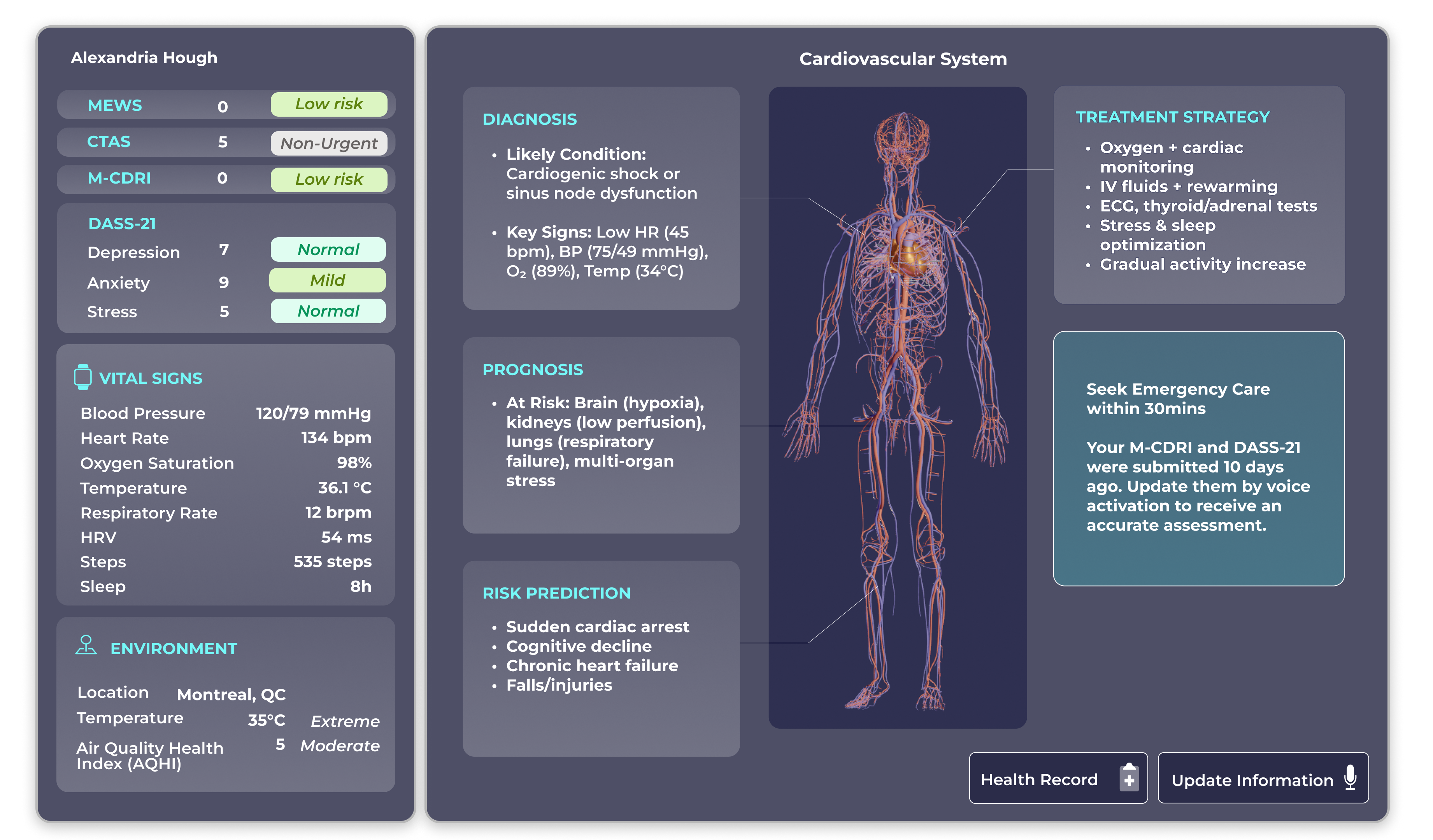
Combining real-time sensor data, voice inputs, health records, and genetic insights to deliver personalized, predictive care and enhance human performance throughout each individual’s evolving journey.
SOLUTION OVERVIEW


The HDT is a smart health and human performance system that leverages a virtual version of a person using real-time data from wearables, voice inputs, medical records, and genetic information. It’s designed to help people stay healthier by predicting risks, supporting differential diagnosis, prognosis, and recommending personalized treatments, both on Earth and in space.
What it does: It continuously monitors your body and environment, understands your health history, and uses a powerful combination of a Knowledge Graph and AI System-Level Autonomy to predict health risks, guide decisions, and adapt care in real time—before issues arise.
How it works: It gathers data from sensors (like smartwatches), voice commands, and medical files, then processes it through secure cloud and edge systems. It presents this information in real time through an interactive 3D interface, including augmented reality.
Why it matters: It empowers high-performance athletes, astronauts, military personnel, and individuals to make smarter, faster decisions about their health and performance—while keeping their personal data private and secure.
WHO BENEFITS?
Space Walks or Extravehicular Activity (EVA)
Spacewalk Health Monitoring and Support Commander Reyes is performing a scheduled 6-hour EVA to install a new solar array. During the mission, his HDT is actively monitoring his health and environmental conditions to ensure safety and performance.
WHAT THE HDT TRACKS
1. Real-Time Data: Vital signs, hydration, oxygen levels, suit pressure, radiation, and movement, automatically collected from suit sensors.
2. Semi Real-Time Data: Voice-activated updates like “feeling dizzy” or “task complete” help the system respond to changing conditions.
3. Foundational Data: Medical history, genetic profile, and baseline health metrics provide a personalized starting point.
WHAT THE HDT DELIVERS
1. Diagnosis: Detects early signs of dehydration and oxygen imbalance.
2. Prognosis: Predicts fatigue and thermal stress risks Risk Prediction: Flags potential performance drops and radiation exposure.
3. Treatment Strategy: Recommends hydration, rest, and timeline adjustments, shared instantly with mission control.
4. Result: Safer, smarter, and more personalized support for astronauts in extreme environments.
Optimizing Athlete Performance
A professional athlete relies on his HDT to monitor his body in real time, anticipate fatigue, and optimize performance. With steep climbs, high altitude, and extreme physical demands, the HDT becomes his invisible coach and safety net.
WHAT THE HDT TRACKS
1. Real-Time Data: Heart rate, power output, cadence, hydration, oxygen saturation, and elevation. Automatically collected from smart wearables and bike sensors.
2. Semi Real-Time Data: Voice inputs like “legs cramping” or “feeling strong” help the system adapt to changing physical and environmental conditions.
3. Foundational Data: Genetic markers, injury history, training load, and baseline fitness metrics provide a personalized performance profile.
WHAT THE HDT DELIVERS
1. Diagnosis: Detects early signs of dehydration and muscle fatigue.
2. Prognosis: Predicts risk of performance drop in the next 30 minutes.
3. Risk Prediction: Flags potential overexertion or heat stress based on terrain and weather.
4. Treatment Strategy: Recommends hydration timing, pacing adjustments, and recovery strategies, shared with the support team in real time.
5. Result: Smarter, safer, and more personalized performance management for elite athletes in high-stakes environments.
Enhancing Soldier Resilience & Performance
During a high-intensity field operation in a remote, high-temperature environment, a frontline soldier relies on the HDT to monitor physical and cognitive performance, detect early signs of fatigue or heat stress, and support mission-critical decisions in real time.
WHAT THE HDT TRACKS
1. Real-Time Data:
Heart rate, hydration, core temperature, oxygen levels, movement, and environmental exposure, automatically collected from body-worn sensors and smart gear.
2. Semi Real-Time Data: Voice-activated inputs like “feeling dizzy” or “requesting status update” allow the system to respond to situational changes.
3. Foundational Data: Medical history, genetic predispositions (e.g., heat sensitivity, stress tolerance), and baseline fitness levels provide a personalized resilience profile.
WHAT THE HDT DELIVERS
1. Diagnosis:
Identifies early signs of heat exhaustion and physical overexertion.
2. Prognosis: Predicts risk of cognitive decline or injury under sustained stress.
3. Risk Prediction: Flags potential mission-impacting fatigue or dehydration.
4. Treatment Strategy: Recommends hydration, rest intervals, or task reassignment, shared with command units in real time.
5. Result: Enhanced safety, sustained performance, and mission readiness through personalized, real-time support in demanding operational environments.
Want to learn more?



